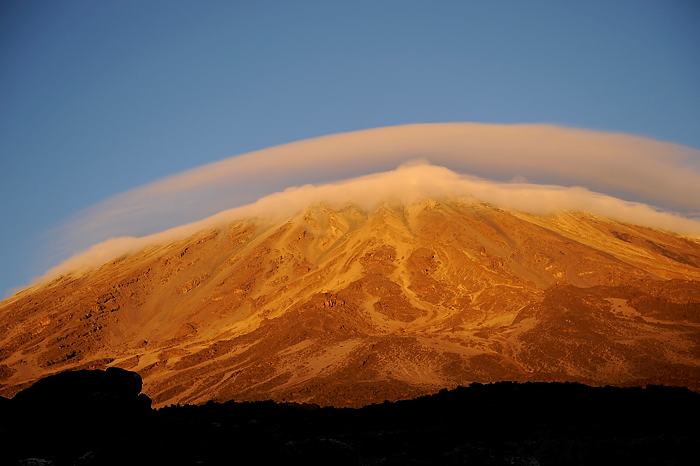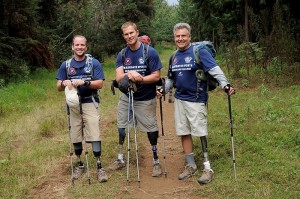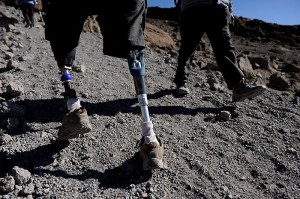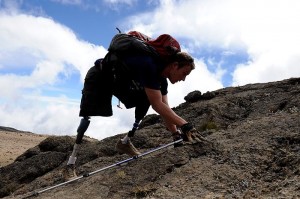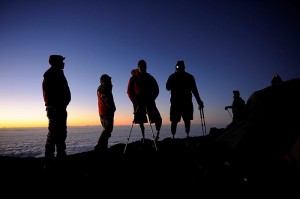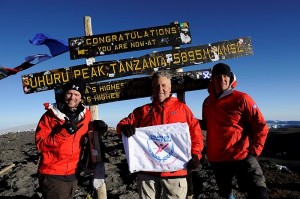This past week I had the opportunity to climb Africa’s Mt. Kilimanjaro with an amazing group of people. Three disabled U.S. Army veterans who’ve lost legs in combat. It was an experience I’ll never forget.
For the last nine months I’ve been helping Disabled Sports USA build an image bank of photos and stories they can use to help promote the work they do with disabled veterans. Two months ago they asked me to join three men who were going to climb Kilimanjaro, as one of them put it, “with one good leg between us.”
Neil Duncan lost both his legs to an IED blast in Afghanistan, and in 2009 came to Tanzania to climb Kilimanjaro. While he was physically prepared,
the trip wasn’t planned for a person with two prosthetic legs, and he had to turn back before the summit. Afterwards he was more determined than ever to make it to the summit, and started working with a local guide (Nickson Moshi) to come up with a plan that had a better chance of success.
He mentioned this to a friend, Dan Nevins, who had lost both of his legs to an IED blast in Iraq. An avid golfer, Dan thought it would be a great challenge. And then Neil asked Kirk Bauer, Executive Director of Disabled Sports USA to join them. Bauer is a Vietnam vet, and lost a leg in combat there.
Their team was rounded out by Scott Kelly, an old friend to DSUSA and the Wounded Warriors Project, and myself, to document the climb.
Kiimanjaro is probably the most accessible tall mountain in the world, and the highest point in Africa. This is because it requires no technical mountaineering skills, just strong legs and a willingness to suffer some. A physically fit person, with proper planning and a good exercise program to prepare themselves, has a good chance of success. The biggest challenge to climbing the mountain is its height. At 19,340 feet, the air at the summit has less than half the oxygen of that at sea level. If you try to climb too fast, you’ll get altitude sickness and have to descend. To acclimate properly you have to climb slowly and give your body time to adjust.
There are several ways to approach Kilimanjaro, and our group used the Rongai route for two reasons – first, it’s one of the

Dan, and the entire group, maintained a strong, positive attitude all the way to the top. Photo copyright Reed Hoffmann.
shortest routes, and second, it’s less rocky than the others, a key consideration for hiking with prosthetic legs. We spent four days going from the start, at 6000 feet, to Kibo Hut, at 15,500 feet. Even using this shorter, less rocky trail, it was a challenge for the team. Missing lower or upper sections of their legs, they have to compensate with other muscles. And, there can be wear and strain at the point where the prosthetics attach to what remains of their legs. Proper care of their bodies and prosthetics would be a key to their success.
Day five had us departing Kibo Hut for the crater rim (Gilman’s Point, over 18,000 feet) in the dark, using headlamps. This was easily the most challenging day yet. In addition to shortness of breath from the altitude, the climbing was fairly steep on loose rock, tough even for someone with two good legs. By shortly after
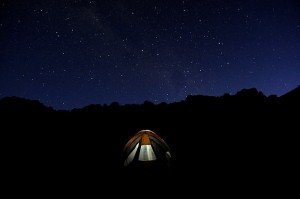
Using a rock as a tripod, this ten-second time exposure shows the beauty of the night sky over the mountain. Photo copyright Reed Hoffmann.
noon we had made the rim, and chose to push on to Stella Point. That would put us closer to the true summit, Uhuru Peak, and even higher, at about 19,000 feet. And this is where the handicapped permit they had applied for would make a big difference. Most people have to ascend climb from Kibo to the summit and back to at least Kibo in one day. Our group, though had permission to camp on the rim, and that’s what we did, spending the night at 19,000 feet. Thank goodness for warm down sleeping bags!
At sunrise the following day, our group made the final push to the summit. It was cold (about ten-degrees), but a beautiful morning without much wind. That meant we could take time to enjoy the success of the climb and the view, and shoot a few pictures. After that it was time to start back down, to warmer weather and relatively thicker air.
As hard as getting to the summit was, going down was even tougher on the team members. The constant pounding on their residual limbs (what they refer to as their “stumps”) took its toll, and the group was moving slowly as they got back to Kibo Hut in the early afternoon. There had been some talk earlier about trying to descend further, but it was soon obvious that wasn’t going to happen. Dan had come down with a high fever and severe headache. Headaches like this are a symptom of altitude sickness, so a quick decision was made to evacuate Dan to lower elevations. That’s done by means of a metal stretcher with one wheel on the bottom, and Dan later said that being hauled down the trail on that contraption was one of the most painful things he’s ever experienced.
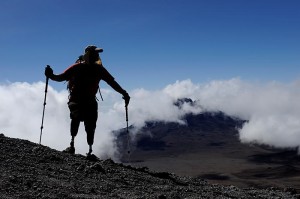
Dan Nevins catches his breath and enjoys the view on the final day’s climb. Photo copyright Reed Hoffmann.
The rest of us took the night to rest and started down the next morning. By mid-afternoon we had to decide whether to push on or stop. The advantage to continuing was an earlier exit from the mountain the next day, so on we went. As the trail became rocky and darkness fell, we questioned the wisdom of that decision. By the time we made it to camp that night, we’d been hiking for 13.5 hours. Exhausted, we fell into our tents. The good news was that we’d made it, and the news on Dan was that he was feeling somewhat better, and would meet us at the exit the next day.
The last bit of the trail out (just another 4.5 hrs) was a nice trail through a beautiful rainforest, where we listened to birds and monkeys (and saw some of both) and enjoyed the lush greenery and flowering plants. As we had hoped, Dan was there at the end
to greet us, and it was great to see him up and feeling better.
After eight days on the trail, the seats in the van felt like heaven and we were all thrilled to be headed to a hotel, hot showers and real beds.
Meeting for dinner that night, we talked about the highs and lows of the last week. All five of us had made it to the top, and four of us had been able to make the entire round trip. Neil felt redeemed after his failure last year. More importantly, Neil, Dan and Kirk hoped that their success would be more than just personal, that others with disabilities would see that with proper planning, almost anything was possible. And that was the true purpose of their climb – to live the motto of Disabled Sports USA: “If I can do
this, I can do anything.”
I’m honored to have been able to be a part of this adventure with such a great group of smart, fun, driven individuals.
To learn more about DSUSA and the trip, visit their website at www.dsusa.org, and take a look at the new www.warfightersports.org website as well.
(Note: Being photographers, I’m sure you’re curious what I carried on the mountain. My kit consisted of a Nikon D700, Nikkor 16mm 2.8, 24-70 2.8 and 70-300 4.5-5.6 lenses, SB600 flash, ten batteries, six 16GB CF cards, Toshiba NB305 netbook and Olympus LS11 digital recorder. I also carried and shot video with a small camcorder that Neil had brought. Because of the amount of dust on the trail and in camp, I cleaned lenses almost every night, and used a blower bulb to keep the sensor clean. My day pack, with camera and audio gear, water, rain/wind gear and miscellaneous, weighed about 30 lbs.)

